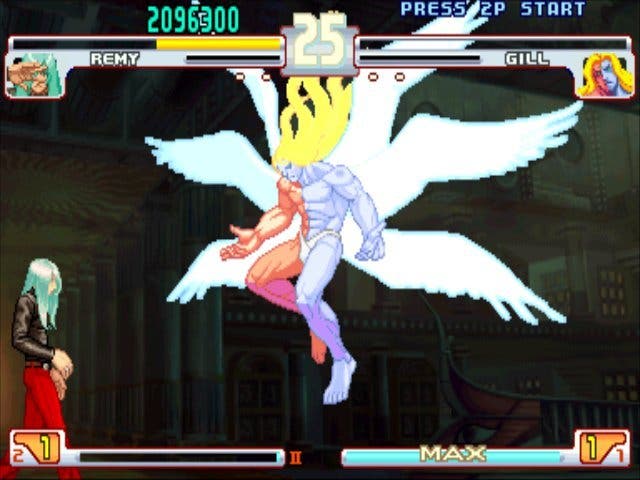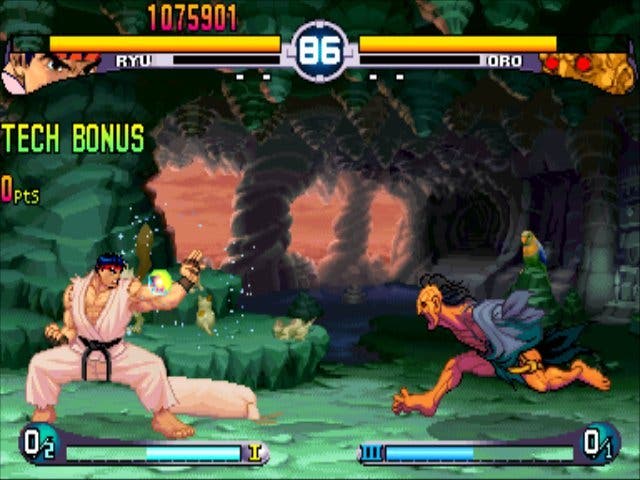Retrospective: Street Fighter
20 years of beat-'em-ups picked thoroughly apart.
Street Fighter III
Series:
(1997) Street Fighter III - The New Generation, (1998) Street Fighter III - 2nd Impact, (1999) Street Fighter III - 3rd Strike
SFIII Mechanics:
- Super Arts - pick the Super that's right for you
- Parrying - completely negate an attack rather than blocking, sets the men from the boys
- Leap Attack - jump slightly and hit a crouching opponent
- EX Specials (2nd) - powered-up specials attacks
- Personal Action (2nd) - elaborate taunts
- Grab Defence (2nd) - throw immediately after being thrown to cancel it
- Red Parry (3rd) - parry during a block, timing is very tight
Up until now I've listed all the Street Fighter games sequentially (I think), but I decided to leave Street Fighter III to last. Capcom's successor to the CPS-2 arcade motherboard, oddly enough, was the CPS-3. It was only capable of 2D graphics in a time when 3D arcade games had taken over, and if it wasn't for the Street Fighter III series, it would be considered one of the greatest arcade flops ever, with only six known games. Fortunately Street Fighter III - The New Generation made the fighter hardcore take notice, and at the time it visually eclipsed all its 2D competitors with stunningly fluid animation.
New Generation initially felt like a mixture of baffling design choices. Ryu and Ken were the only returning Street Fighters on the character-selection screen, and rumour has it Capcom only included them at the 11th hour. Filling the many gaps were the likes of ninja Ibuki, Kung Fu practitioner Yun and grappler Alex. Some of the other characters had a similar feel to the old Street Fighter II cast - Dudley was a boxer like Balrog and Necro's extending arms and electric attacks played like a Dhalsim and Blanka hybrid.

The gameplay also seemed more Street Fighter II than Alpha. Players had to choose just a single Super move from a selection of three and air blocking had been completely removed. But in its place was the new parry system. By pressing forward or down in time with an opponent's attack, the player could negate all damage, leaving just enough time for a counterattack. Many players were apathetic towards the parry system initially, but it nonetheless provided a dual offensive/defensive system that required serious skill to master.
In times when arcades were becoming dominated by Tekken 3 machines, observant players may have noticed the New Generation cabinets being upgraded to Second Impact. Visually even more impressive than New Generation, Second Impact brought new characters Hugo and Urien into the fray as well as bringing back Akuma. Yang, Yun's palette swap from New Generation, was also given his own moveset.
Second Impact didn't really change the basics of New Generation that much - except in the case of EX specials. By pressing two buttons rather than one, the player could execute a special move that cost a small portion of their Super meter, but was stronger than the heavy special and had higher priority. This technique is being brought back for Street Fighter IV and its implementation will be one of the first steps to Street Fighter IV mastery.
As good as New Generation and Second Impact were, they were mere precursors to the excellence that was Third. On the face of it Third Strike didn't progress Street Fighter III all that far. It brought back Chun-Li and added four new fighters including Makoto and Remy, but Remy's Light of Virtue and Rising Rage Flash were just Guile's Sonic Boom and Flash Kick in disguise. Behind the scenes though, all the characters' moves were tweaked to near-perfection and little changes, like air parrying not pushing you back like it did in New Generation, all added to Third Strike's brilliance.

I'll probably get scorned for using such an obvious example, but Diago Umehara's well-documented fight with Justin Wong, during the losers' bracket final of the Evo Champion Series 2004, is a classic example of the parry system mastered. On the brink of defeat, where even blocking a hit would cause him to lose, Diago waits for Justin to pull off Chun-Li's rapid 15-hit Super, the Houyoku Sen. Diago, to everybody's surprise and not least Justin's, parries every single agonising hit and follows up with a perfectly-executed 12-hit combo, Super Cancelling into Ken's Shippu Jinkai Kyaku. The crowd goes mental and the most famous Street Fighter battle ever is born.
Third Strike was simply classic 2D fighting perfection. It didn't get bogged down with 50 characters or overly complex play mechanics, but instead got all the fundamentals right and tight. Many disliked the new cast and couldn't get to grips with the parrying, fair enough, but to my eyes Third Strike is not only the greatest Street Fighter, but also the greatest fighting game made up to now, and the standard by which the long-term success of Street Fighter IV shall be judged. Nearly ten years old, Third Strike is still possibly the most hotly contested fighting game in Japan, and for damn good reasons.
And the rest...
(1990) Street Fighter 2010
A platform game on the NES that doesn't really have anything to do with Street Fighter, although it was developed by Capcom. In the Japanese version the main character was a cyborg cop called Kevin Striker sent out by the galaxy police to control a parasite outbreak. The English localisation team saw an opportunity to make some quick cash and so changed Kevin to Ken. The story read: "even though it's been 25 years since Ken was king of the street-fighting circuit, it's nothing a few good bionics can't fix". To be honest, Ken's cheap enough without bolting machineguns to his arms.

(1995) Street Fighter - The Movie
As if it wasn't bad enough that they made Street Fighter into a live-action movie, Capcom had to make things worse by releasing a game based on the movie of the game. Two versions of "The Movie" were made - the arcade version was developed by Incredible Technologies and the Saturn and PS1 home version was developed by Capcom. Both games used digitised sprites like Mortal Kombat in a vague attempt to replicate the actors onscreen. Although the games had slightly different mechanics, they had one major thing in common - compared to Street Fighter II they were horrendously bad. If you ever get the chance to play one however, it can be quite funny regardless.
(1995) Street Fighter II: The Interactive Movie
Unlike the above, Street Fighter II: The Interactive Movie is an adventure game based on the anime Street Fighter II: The Animated Movie (which is awesome). Released for the Saturn and PS1 in Japan only, the player took control of a Shadaloo monitor cyborg searching for Ryu across the world. The game also spliced in footage from the film and had playable fights based on the Super Street Fighter II engine.

(1997) Super Gem Fighter Mini Mix
Using the same deformed style from Super Puzzle Fighter II Turbo, Super Gem Fighter included characters from Street Fighter, Darkstalkers and Red Earth. Originally released in the arcades, it had just four buttons - Punch, Kick, Taunt and Special - and although specials were pulled off in the normal manner it played very differently to any other Street Fighter. Players had to collect gems during fights to power-up their three different specials. Super Gem Fighter also had a cosplay vibe, with combo sequences dressing Akuma up as Leo from Red Earth and Chun-Li as Jill Valentine.
(2004) Capcom Fighting Jam
Probably still fresh in most fighter fans' memories, Capcom Fighting Jam was an in-house crossover featuring fighters and their inherent systems from Street Fighter II, Street Fighter Alpha, Street Fighter III, Darkstalkers and Red Earth. The game was poorly received due to its lack of originality, character simplification and unbalanced roster. The only original character, Ingrid, was salvaged from the canned Capcom Fighting All-Stars, which sums Fighting Jam up quite well.
Look out for Eurogamer's Street Fighter IV review very soon.








